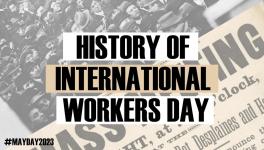May Day: The History of Class Struggle

Image Courtesy: Unión del Barrio
The history of May Day is the history of the struggle of workers to work and live a dignified life.
Indeed, all people who work for an employer to earn a living (across socio-economic classes) have the sacrifices made by workers and trade unions worldwide to thank for the rights we avail — such as sick leaves, weekends offs, safer working conditions, and even the right of workers to collective bargaining through unions, etc.
The demand for the ‘eight-hour workday’ is inextricably tied up with the origin of ‘Labour Day’ — May 1— or the Day of International Solidarity of the Working Class.
In the nineteenth century, after the advent of the industrial revolution in Western countries, exploitation of workers in factories was intensified. The capitalists forced the workers to put in inhumanly long hours so that the profits — of which the workers had no share — could be maximised.
In 1834, for example, during a bakers’ strike in New York, a publication called the Workingmen's Advocate stated (as cited here):
“[…] Journeymen employed in the loaf bread business have for years been suffering worse than Egyptian bondage. They have had to labor on an average of eighteen to twenty hours out of the twenty-four.”
In the United States of America, in the years that followed the Civil War of 1861-65, the workers’ movement gradually grew stronger as workers in various sectors of industry organised and trade unions led the way with demands for not only higher wages but, even more urgently, for better working conditions, encapsulated in the slogan for the shorter workday — “Eight hours for work, eight hours for rest, and eight hours for what we will!”
But it was in Australia in 1856, as revolutionary political theorist and economist Rosa Luxembourg has pointed out, that workers decided “to organize a day of complete stoppage together with meetings and entertainment as a demonstration in favor of the eight-hour day.”
This celebration and stoppage of work took place on April 21, and this celebration of proletariats was repeated in the years to follow.
“The first to follow the example of the Australian workers were the Americans,” she writes.
In 1884, the Federation of Organized Trades and Labour Unions called for the beginnings of a countrywide movement.
In 1886, May 1 was declared as the day of universal work stoppage by the workers, led by a national union, predecessor to the American Federation of Labor (AFL). This was the day workers decided that they would stop working more than eight hours.
Over 200,000 workers went on strike and marched in protest nationwide, but the biggest gathering was in Chicago. There were protests the next day we well. On May 3, some picketing workers at the McCormick Reaper Plant at Western and Blue Island Avenues were attacked and killed by the police.
Also read: International Workers Day: A Day of Struggle, A Day to Resolve to Struggle
On May 4, there was a peaceful protest gathering at Haymarket Square. But an unidentified person threw a bomb, and using the explosion as a pretext, the police opened fire killing at least four workers and went for mass arrests.
In 1886, the leaders of the workers’ movement — August Spies, Adolph Fischer, George Engel and Albert Parsons were hanged on false charges of being involved in the bomb blast.
In 1890, the Second International adopted May 1 as the day of mobilisation of workers worldwide to fight for the eight-hour day. This was also the first May Day celebration.
May Day In India
In India, the first trade union — the All India Trade Union Congress (AITUC) — was formed in 1920.
It is widely accepted that the first Labour Day celebration was organised in 1923 by the Labour Kisan Party on Marina Beach in the city of Madras (now Chennai).
However, there had been struggles and movements going on by workers even earlier, as Tapan Sen, the general secretary of the Centre of Indian Trade Unions (CITU), points out:
“In India, the first ever strike by workers over shorter working hours was held in Howrah district of pre-Independence Bengal some years before 1923.”
It was with the Factory Act of 1926 and the subsequent legislations and amendments over decades that Indian workers won whatever rights they have today. May Day was eventually declared a holiday in most states of the country.
However, the importance of May Day needs to be emphasised now more than ever — as the hard-won (but far from adequate) rights of the workers are now under attack by neoliberalism since the early 90s after India gave into pressure by the international financial institutions to “liberalise” its economy and decrease protections for workers, and even more so in the past five years by the BJP government in an unprecedented manner.
As Sen told NewsClick, “At present, the government is using the three-pronged mechanism of contractualisation, ‘fixed-term’ employment, and apprenticeship to attack workers, give industries the freedom to hire and fire at will, and effectively create conditions of slavery. They are changing the patterns of employment relations without needing to go for legislative changes. But workers across the country have been fighting and are determined to keep fighting.”
On this May 1, as all of the Central Trade Unions (except for the RSS-backed one) gave a call for May Day rallies in Delhi and other parts of the country. Workers are renewing their pledge to continue their struggle against oppression and exploitation, and to not stop fighting until they receive their shares from the ruling class.
As Karl Marx said in 1848: “The proletarians have nothing to lose but their chains. They have a world to win. Workers of all countries, Unite!”
Also read: Celebrating International Workers’ Day in the Indian City: Changing Work and Changing Workers
Get the latest reports & analysis with people's perspective on Protests, movements & deep analytical videos, discussions of the current affairs in your Telegram app. Subscribe to NewsClick's Telegram channel & get Real-Time updates on stories, as they get published on our website.
























